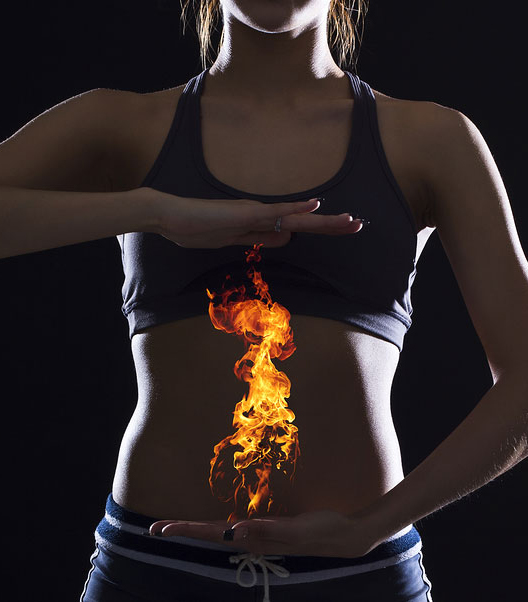
Introduction to Agni
The term agni stands for the biological fire. Agni, the biological fire is not only vital at physiological but at pathological levels, also. Just like food stuffs are required by the human body regularly for nutrition, the agni or the digestive fire need regular feeding in order to carry out physiological biochemical pathways in the human body body.
Majority of the health disorders are the outcome of improper functioning of the agni as it is central subject to the health. The role of agni is not limited to absorption of macronutrients as well as micronutrients, but is essential for destruction of microbes and pathogens. The food-stuffs which are not properly digested are referred to as “ama” in Ayurvedic system of medicine. Ama or toxic substance is responsible for origin of diseases like rheumatoid arthritis.
Normal functioning of agni or the digestive fire is evident from normal function of the gastro-intestinal, heart, strong resistance or immunity against pathogens and diseases, proper health, and above all, the complexion of the face. Thus agni has great description physiological significance.
If agni or the digestive fire is not working in a proper fashion, there is poor digestion, sluggish blood-circulation, poor stool formation, infections, poor energy levels, and poor impaired immunity against pathogens and diseases. According to the Ayurvedic principles, improper functioning of the digestive fire is the root cause of the clinical diseases.
Types of Agni as per Ayurvedic Lexicons
- Charaka has described about 13 Agnis (Jatharagni – 1, Bhutagni – 5, Dhatvagni – 7),
- According to Sushruta, five types of Agnis are identified, (Pachakagni (concerened with digestion), Ranjakagni(concerened with colouration of bile-pigments), Alochakagni (concerened with vision), Sadhakagni (concerened with digestion) and Bhrajakagni (concerened with brain),
- Vagbhata has described different 18 types (Bhutagnis –5, –Dhatvagnis–7, Dhoshagni – 3 and Malagni–3),
- Sharangadhara has recognized five pittas only (Pachak, Bhrajak, Ranjak, Alochaka and Sadhak),
- Bhavamishra theory is similar to Vagbhata and Charaka.
Functions of the Agni
Being one of the five elements, agni or fire has one typical characteristic that it has no existance without the biological fire, pitta dosha.
Agni is Responsible for the Following Functions:
- Pakti- Apakti (Digestion-indigestion)
- Darshanam- Adarshanam (Vision- absence of vision)
- Matra- Amatratvamushmanala (Degree of heat)
- Prakrit – Vikarit varnam (Norma -abnormal complexion)
- Shaurya- Bhaya (Prowess- fear)
- Krodha- Harsham (Anger-exholoration)
- Moha- Prasadan (Confusion- clarity of mind)
Role of Pitta in Aharapaka
Pitta, the biological fire, is one three biological humours of the human body. All the matter in the universe is composed of the five-elements or panchabhootas. The name is according to the predominance of either of the five-elements or panchabhootas. Accordingly, the Agni or fire represents the pitta. Since Agni is working continuously inside the human body, it is known as antaragni or internal fire. When pitta or biologica fire increases, the agni becomes tikshnagni, which has capacity to peform quick digestion of various food stuffs. According to Susrutha, pitta is vishad non-sticky, a characteristic due to whcih, pitta performs the process of aharapaka and dhatupaka.
Stages of Aharapaka
For the carrying out metabolic processes in the body, there are three main groups of biological factors, probably exhibiting enzymatic functions (agnis).
Jatharagni or Koshthagni
Jatharagni is present in the form of the pachak pitta (a variety of pitta). Jatharagni is primarily responsible for the process of digestion and the absorption of nutritients during this whole process going in the gastro-intestinal tract.
The process of Aharapaka or food-digestion is divided in three stages, (collectively known as awastha paka) and can be further divided in the following:
- Amavstha or madhuravastha paka (occurs in the amashya or stomach),
- Pachymanavastha or amlavstha paka (occurs in the grahani or duodenum),
- Pakavstha or katuavstha paka (in small and large intestine)
The rasa is exposed to various changes during the different phase of digestion (this phase of digestion is known as avsthapaka). When the process of the digestion is complete, the digested food possess the original rasa which is similar to wthe rasa of the food ingested (this phase of digestion is known as Nistha paka. Nistha paka is popularly known as Vipaka.
Bhutagni (Elemental Fire)
Bhutagni is present in the one of the element, precisely known as, Panchmahabhutas.
These are Five in Number, Namely:
- Parthiva or earth,
- Apya or water, Agni or Tejas,
- Vayavya or vayu,
- Nabhasa or akash.
Dhatvagni (Tissue Fire)
All the seven dhatu (tissues) of the human body posses their own fir or agni in order to metabolize the macro and micronutrients supplied through the channels of circulation.
- Rasagni present in the Rasa Dhatu (plasma)
- Raktagni present in the Rakta Dhatu (blood)
- Mamsagni present in the Mamsa Dhatu (muscle fiber)
- Medagni present in the Meda Dhatu (adipose tissue)
- Asthyagni present in the Asthi Dhatu (bone)
- Majjagni present in the Majja Dhatu (bone-marrow)
- Shukragni present in the Shukra Dhatu (seminal fluid or semen)
